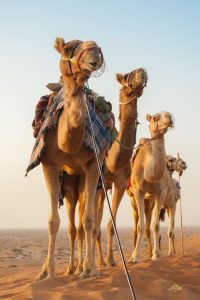In Northern Kenya, camels are very popular and are kept due to their highly valued milk and meat. Camels are traditionally reared under pastoral farming, usually in communally owned rangelands.
Kenya has the fifth largest population of camels in Africa, after Somalia, Sudan, Mauritania, and Ethiopia. The country is home to 4.6 million camels, according to the Kenya National Bureau of Statistics (KNBS) 2019 census, nearly 10 percent of all camels in the world.
Their unique physiological, anatomical, and ecological adaptations enable them to supply milk to pastoral households throughout the year. Other uses include: supply of meat, blood, draught power, transport, recreation, wool and fibre production, leather, bones for making jewellery, cultural and religious significance.
Kenya Agricultural & Livestock Research Organisation (Kalro) in a recent report – Disseminate Improved Camel Management Technologies for Improved Milk and Meat production in the Arid and Semi-arid Lands (ASALs) says, the quality of a camel’s milk is similar to a cow’s in many aspects.
Fundamental differences, however, exist in butter fat, vitamin C and protein content. Camel milk has a low butterfat content (3.7%) compared to that of cows (5.7%) and does not separate easily. The milk is rich in vitamin C ranging between 5.7 – 9.8 mg% and three times the level in cow milk.
This is very important in ASAL regions where fruits and vegetables are not available as a source of vitamins. The protein lactoferrin in camel milk is about 10 times the cow’s milk. Protein lactoferrin and vitamin C in camel milk give the milk medicinal properties against viral and bacterial infections,” the report says.
The Kenya Camel Association estimates that camel milk and meat value chains contribute about KShs14 billion into the economy and support more than three million households.

However, there is potential to double the value through private-public partnerships. “The potential of camels to provide meat, milk, hides, bones, and manure has not been well exploited. This amounts to lost opportunities for investment, employment creation, food, and subsequently economic improvement,” the association stated in a statement.
Generally, in Kenya, camel products – milk, meat, and hides – are mostly consumed or used by communities that traditionally keep them. However, the uptake of these products is beginning to spread, as more people discover their health benefits.
The association further says there is still need to deliberately popularise camel products, particularly meat and milk. “It is a gigantic task that needs concerted effects of more stakeholders.”
Lately, camel milk has grown in popularity, and according to the annual Camel Dairy Market Report (2021 – 26) published in February 2021, the global market reached a high of $2.3 billion in 2020 and is forecast to grow at eight percent per year. The UN Food and Agriculture Organization (FAO) in sub-Saharan Africa says camels contribute about five percent of total milk production. They generally produce “under low-input, low-output systems,” hence five litres a day is considered a decent yield.
Abdi Ibrahim, a herder in Isiolo, who owns 180 camels says the animals are the most preferred livestock in the region as they can survive in harsh environments, compared to cattle and small stocks.
“Camels are of great economic importance to locals since they are multifunctional animals providing the local communities with milk, meat, hide and skin, as well as transport. Also, a mature camel can fetch more than KShs100,000 in the local market,” said Mr Ibrahim.
A report dubbed Climate Risk Profile for Isiolo by the Kenya Climate Smart Agriculture Project (KCSAP) produced in partnership with the World Bank, indicates that camel milk is one of the most strategic value chains in Isiolo, a major source of food security and income for the county’s population and holds a significant cultural value.
The report shows that the product contributes up to 50 percent of the total household nutrient intake and 30 percent of the annual caloric intake.
There are approximately 39,084 camel heads in greater Isiolo region, yielding roughly 22,500 litres of milk per day; out of these, only 4,500 litres of raw milk are supplied to the main Eastleigh market in Nairobi accounting for 70 percent of marketed camel milk. The rest is sold in the local market in Isiolo Town or used for household consumption.
Marketing of camel products is mainly through informal and unregulated market chains whether this involves export of live animals or sale of camel meat and milk in town centres. Its contribution to the national GDP can only be estimated but is not fully taken into consideration.
Poor roads and marketing infrastructure in camel rearing areas is also a major hindrance in the growth of the markets and potential private investors. Investments into road and market infrastructure need to be looked into in order to improve the trade. In the local markets, production and quality of the product needs to be improved, that is, through the formation of market groups and/or co-operatives.











